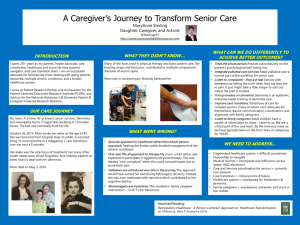 This post by SPM member MaryAnne Sterling is a thrilling sequel to our ongoing posts about CCCC (an organizational member of our Society) and its support for e-patients at their annual summit. MaryAnne is CEO of Sterling Health IT Consulting. She’s a healthcare transformer and Alzheimer’s activist whose motto is: no family caregiver left behind.
This post by SPM member MaryAnne Sterling is a thrilling sequel to our ongoing posts about CCCC (an organizational member of our Society) and its support for e-patients at their annual summit. MaryAnne is CEO of Sterling Health IT Consulting. She’s a healthcare transformer and Alzheimer’s activist whose motto is: no family caregiver left behind.
The 9th Palliative Care Summit was held recently in Sacramento, convened by the Coalition for Compassionate Care of California (CCCC) and the Children’s Hospice and Palliative Care Coalition. In January we blogged here that PCORI (Patient Centered Outcomes Research Institute) had issued a grant for e-patients to attend, and asked for applicants. Fifteen e-patients were selected to participate in the event this year – way up from the five we blogged about last year. I was thrilled to be one.
But we didn’t just “participate”; we drove the conversation – on multiple levels. This should be a model for other healthcare conferences to follow. Why? Read on.
We were a group of diverse e-patients from around the country (and globally) who had a well-organized and thoughtful program waiting for us even before we arrived in Sacramento. The Coalition gathered us by phone for planning purposes several weeks in advance. As part of the planning process, we were invited to create posters that illustrated our journeys. I hesitated at first, somewhat reluctant to tell our family’s story, because it is still very raw – having lost my mom last May. But I proceeded to create a poster (right) with the goal of helping others learn from our experience.
Our first evening was spent getting to know one another and participating in a facilitated workshop designed to elicit our thoughts on defining palliative care and taking it mainstream. This exercise resulted in concrete action items that participating e-patients are implementing post-Summit. My commitment: to use social media to teach others about palliative care.
Day one of the Summit began with a warm welcome of e-patients from the podium and an explanation of our role to Summit attendees. Our pictures and bios were featured in the Summit program. We were ready. As speakers lined up to enlighten us, we began Tweeting. #CCCC17 was soon trending on Twitter. The sharing of information and ideas had begun!
In the main hall, our posters, art, brochures, and videos were displayed prominently, drawing attendees in to learn more. Impromptu conversations began between creator and viewer. Knowledge was shared.
Two of our e-patient experts, Charlie Blotner and Rachael Goldring, participated on a panel titled “The Road Unpaved: When Young Adults Become Engaged Patients.” Their perspective was illuminating for many, judging by the quality of questions posed to them by the audience.
From the opening keynote to the final activity of the day – a viewing of Academy Award Nominated Extremis and a discussion with its star, Dr. Jessica Zitter – we kept social media buzzing.
Day two: one of the highlights from day two was “e-patient office hours,” where attendees gathered to ask questions in a more casual setting. The conversation was open and honest. The topics were tough. As several e-patients related their personal stories – many of which were difficult to hear – audience members participated in lively discussion with us. The end result was a deeper understanding of the patient/family caregiver experience and how palliative care could benefit us, especially if introduced in situations where chronic illness doesn’t necessarily mean end-of-life.
As with day one, e-patient art, posters, brochures, and videos were inspiring conversation. I knew I had made a difference when I saw an attendee reading my poster, with tears in her eyes.
Ultimately, measuring the success of e-patients as contributors to this event is perhaps subjective. But, those attendees who interacted with us seemed to glean new understanding and appreciation for the patient/family caregiver experience. For me, this was the measure that mattered most.
To learn more, you can access conference videos and materials here.








Recent Comments